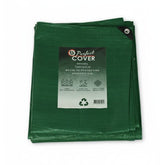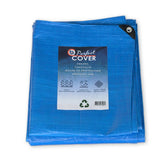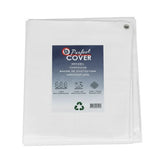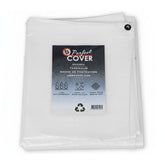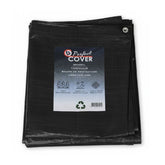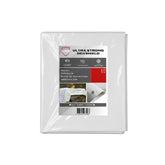1. Protection against the elements
Construction projects often experience unpredictable weather conditions that hinder progress. Rain, wind, snow, and other elements can not only cause delays but also seriously damage materials, resulting in additional costs and delays. In this regard, tarpaulins are invaluable.
Rain is one of the biggest enemies of building materials. Exposure to moisture can cause wood to expand, drywall to warp, and cement to harden before it has a chance to bond properly. Strategically placing tarps over building materials and unfinished structures creates a waterproof barrier that prevents rainwater from penetrating and causing damage.
Tarpaulins also protect against strong winds. Wind can blow loose materials around and throw them around like projectiles, which is not only dangerous for workers but can also damage property and finished parts. By securely fastening tarpaulins, the wind on the construction site is limited and hazardous situations are prevented.
In colder climates, snow poses an additional challenge. Accumulation of snow can delay work at height, while meltwater increases the risk of moisture problems. Strategically placed tarps provide protection from snow and prevent meltwater from penetrating unfinished building elements.
Besides rain, wind, and snow, tarpaulins also protect against bright sunlight and extreme temperatures. Excessive sunlight can discolor, dry out, or damage materials, while temperature fluctuations can affect the properties of certain building materials. Using tarpaulins as shade cloth or insulation protects materials and structures from these elements.
In short: Tarpaulins play a crucial role in protecting against the elements, ensuring a streamlined construction process, and safeguarding the quality of work. Their versatility and effectiveness make them indispensable for construction professionals worldwide.
2. Moisture regulation
One of the biggest challenges during construction and renovation projects is controlling moisture. Moisture buildup in materials and structures can lead to mold, wood rot, corrosion, and compromised structural integrity. Proper tarp installation is an effective way to address these problems and extend the lifespan of construction projects.
Tarpaulins act as a moisture barrier, preventing rain, meltwater, condensation, and other moisture sources from penetrating materials. This is especially crucial during the shell construction phase, when a building isn't yet waterproof. Consider covering roofs, floors, walls, or other vulnerable components.
In addition, tarps help regulate humidity on the construction site. By keeping moisture out, the risk of mold growth decreases. This is especially important in humid climates or seasons.
Tarpaulins can also be used to demarcate damp areas and prevent further spread of moisture, for example in renovation projects where leaks occur.
Conclusion: By strategically using tarpaulins within a moisture management plan, construction professionals can mitigate moisture-related problems and ensure the sustainability of their work. Investing in quality tarpaulins and proper maintenance delivers significant savings and customer satisfaction.
3. Protection of building materials
Materials like wood, cement, steel, and plasterboard are vulnerable to moisture, mechanical damage, and external influences such as dust, dirt, and chemicals. Tarpaulins protect these materials throughout the entire construction process – from delivery to completion.
Moisture is often the biggest culprit. Wood can warp, cement can harden prematurely, steel can rust, and drywall can swell and become unusable. Tarpaulins provide an effective barrier against moisture, protecting materials from rain, snow, and condensation.
Besides moisture, tarpaulins also repel dust, dirt, and chemicals. This keeps the materials clean and intact, contributing to the quality of the final result.
In short: Tarpaulins are essential for maintaining the quality of building materials. Their timely and correct use extends their usability, limits damage, and reduces repair and replacement costs.
4. Temporary storage
On a construction site, efficiency is crucial. Materials are often delivered in large quantities but only used later. Tarpaulins offer a practical solution for temporary storage, providing protection against the elements, theft, and damage.
Temporary on-site storage offers flexibility. Materials can remain in place until needed, reducing transport and logistics costs. A tarpaulin provides protection against rain, snow, and wind, keeping materials in optimal condition.
In addition, a tarpaulin helps prevent theft. Covered materials are less noticeable and less accessible, which increases security.
Tarpaulins can also be adapted to the shape and size of the stored materials – from large wood packages to smaller tools.
Conclusion: Using tarpaulins for temporary storage promotes efficiency, reduces risks and extends the life of materials.
5. Flexibility and adaptability
One of the biggest advantages of tarpaulins is their flexibility. They can be used in a variety of construction conditions and easily adapt to different needs and locations.
Tarpaulins are available in a variety of sizes – from small pieces to large areas – making them suitable for covering both small material stacks and entire work areas.
They also come in various shapes, including rectangular, triangular, and round, allowing them to be perfectly matched to the geometry of the construction site.
They're also available in a variety of materials, from heavy-duty PVC to lightweight polyethylene. This allows you to choose based on durability, weather resistance, or budget.
Various fastening options – such as eyelets, hooks, Velcro or elastic bands – make it easy to secure tarpaulins, even in strong winds or changing conditions.
In short: Thanks to their adaptability, tarpaulins are a versatile and cost-effective tool for any construction project, large or small.
6. Reuse
One of the most important properties of high-quality tarpaulins is their reusability. This makes them a sustainable and cost-effective solution for projects of any size.
High-quality tarpaulins are made of strong materials that are resistant to UV radiation, extreme temperatures, and mechanical stress. This ensures they last a long time and can be used for multiple projects without loss of quality.
Reusing tarpaulins saves significant costs in the long run.Instead of purchasing new ones every time, they can be used repeatedly, resulting in less waste and better project budget management.
Moreover, reuse contributes to more sustainable construction practices. Less waste means less impact on the environment – something that is increasingly valued in the modern construction industry.
In summary: Reusable tarpaulins are a valuable investment that contributes to efficiency, sustainability and cost savings.
Closing message
Tarpaulins are the silent force behind successful construction projects – protective, flexible and durable. Invest in high-quality tarpaulins from
Discover our range and experience how tarpaulins can take your projects to the next level.


